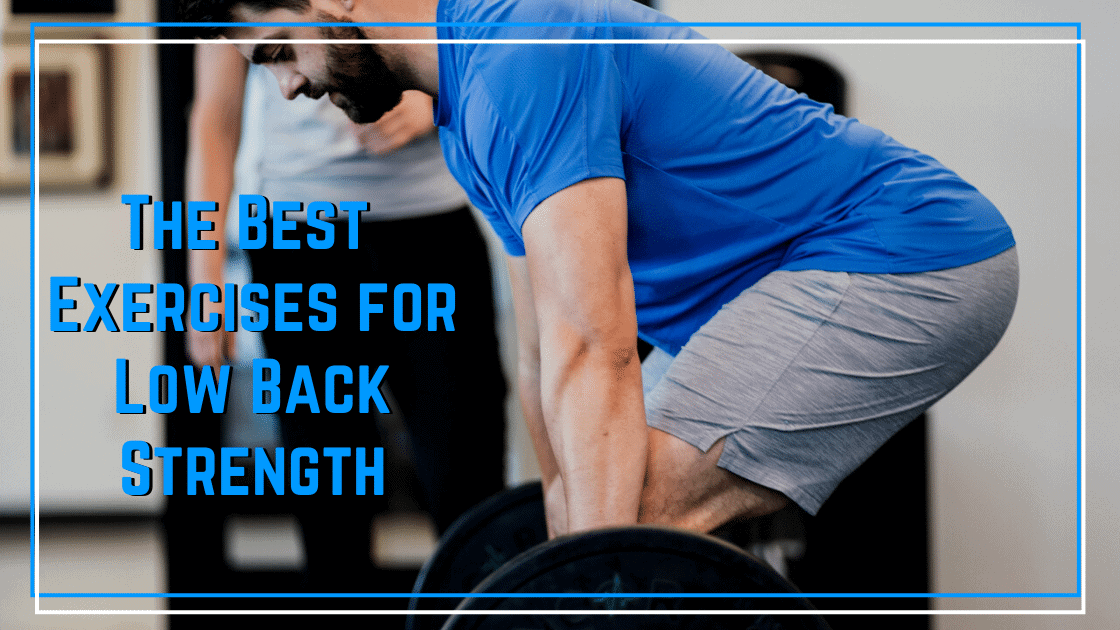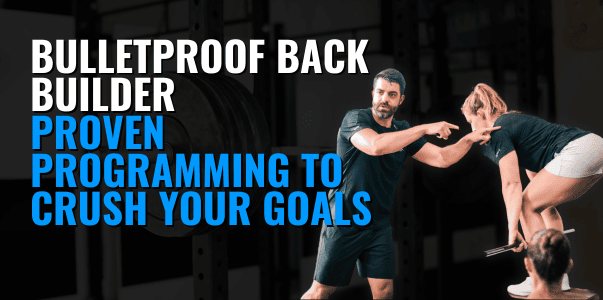Whether your goal is to PR your squat and deadlift, or to simply finally get long-lasting relief from low back pain, strengthening the muscles of your lower back is important. While I believe firmly that the deadlift is the best exercise you can do to strengthen your lower back, there is a lot of value in having other exercises to help you isolate low back strength.
Commonly, we focus on core muscle development by training the abdominal muscles. But, if we think of what the barbell is trying to do to us doing squats, deadlifts, etc., it is trying to round the back over. So, for bigger PRs, we should probably make sure our training program work dynamic and isometric strength of the spine itself.
For athletes wanting to build a strong low back, whether for performance or injury reduction reasons, check out our Bulletproof Back Builder. This plan has helped hundreds of athletes build a stronger, more resilient back.
Who Needs To Focus on Low Back Strength?
Before diving into my favorite exercises for strengthening the lower back muscles, let’s take a step back and discuss who should focus on lumbar spine strengthening.
In general, when I see the follow things in athletes, I’ll begin programming accessory low back strength exercises:
- Athletes who have a squat to deadlift ratio imbalance. While many things can contribute to this (so this ratio is not always perfect), when someone squats significantly more than 80% of their deadlift max, we focus on back strength
- In the squat, we’ll often notice athletes with a low back weakness being fast out of the hole and then hitting a brick wall halfway up during max effort lifts and then their back rounds forward. Fast legs out of the hole and then the back can’t keep up. This sounds similar to the good morning squat but is important to note this low back weakness does not occur until the sticking point of the squat whereas the good morning occurs right out of the hole
- Another imperfect test, but I like my fitness athletes to be able to hold a two-minute Sorenson hold
- Finally, research studies have repeatedly found that individuals with low back pain that strengthen that area tend to see improvements in pain, quality of life, and functional tests. These studies have seem benefits in strengthening the back for patients with non-specific low back pain, chronic back pain, and low bone mass.
The Best Exercises for Low Back Strength
Because I am writing this with the goal of both helping those in pain and those going after purely performance goals, you’ll see a wide range of difficulty in these movements. I’ll put these exercises in a progression from conservative exercise variations to more advanced below. While there is still some benefit to doing some of the lower-level exercises even if you are purely performance-oriented, those chasing maximal strength should focus more on the later exercises in this low back strength progression.
Chinese Plank
The Chinese Plank is a great starting point for building low back endurance in individuals, especially those dealing with highly irritable low back pain. Because we are holding an isometric rather than moving much, most individuals tolerate this well. We also aren’t going into a hip hinge pattern which in more irritable back pain can be aggravating at times.
The Chinese Plank allows us to pump some blood into the back and begin building more low back endurance. For those with greater strength, placing weight plates across the hips can make the exercise more difficult to match their fitness level.
Sorenson Holds
The Sorenson Hold is one of my tests to determine if someone has good low back endurance. For most of the athletes that I work with I like to see them be able to hold this for 2-minutes. If they can’t, simply performing submaximal endurance holds is a great way to begin strengthening. This will be more challenging than the Chinese Plank discussed above and can easily be progressed to more advanced GHD variations such as the ones discussed in this article and below.
GHD Rows
One of the easiest ways to progress the GHD Sorenson Hold is to add a row to the movement. You won’t need to go heavy here to make this and incredibly difficult lumbar muscle strength exercise.
Reverse Hypers
The Reverse Hyper machine is a popular posterior chain strengthener. But most gyms don’t have one. We can still get tons of low back isolated strength and build spinal erector muscle mass by performing the same movement with some of the below RH variations. Add bands around your legs, ankle weights, etc to increase the challenge as needed.
If you are in the market for a Reverse Hyper, our favorite is the Westside Scout.
Bent-Over Row
Barbell bent-over rows are highly underrated as a low back strengthening exercise. But it puts a lot of load on the lower back muscles. When I’m performing with the goal of strengthening the low back, I tend to use a little body momentum to get the weight moving up rather than staying super strict.
GHD Hip Extensions
We can bump up our glute-ham developer low back variations by loading GHD hip extensions up. Grab a barbell, dumbbells, or use bands as shown below for added challenge.
Good Mornings
Now we are getting to the toughest low back strength exercises. The good-morning exercise will really tax the low back as your spinal erector muscles fight to keep your back locked in place as you hinge forward. Try different stance widths, bar positions, and even letting spine position move into a bit of flexion to find what setup hits your lower back muscles the best.
Rack Pulls
Rack pulls are simply deadlifts where the weight is pulled from an elevated surface. With the conventional deadlift, most athletes think of it as a pulling motion. But the initiation of the deadlift comes from a big leg drive and the quads pushing the bar off the ground. By elevating the bar we’ll reduce the leg drive and puts more emphasis on the back muscles.
There are a ton of other low-back strength exercises. But these 8 tend to be the ones I prescribe the most to fitness athletes.
Looking for more help building your backup for that next PR or post-rehab low back strengthening? Our Bulletproof Back is a great accessory plan. Four weeks of workouts lasting 10-15 minutes will compliment your current training without interfering with recovery.







